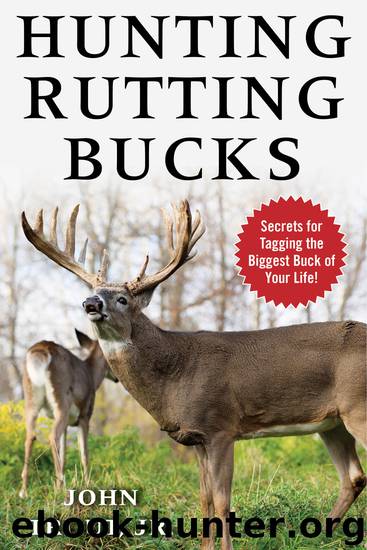Hunting Rutting Bucks by John Trout

Author:John Trout
Language: eng
Format: epub
ISBN: 9781510738690
Publisher: Skyhorse
Published: 2019-05-30T16:00:00+00:00
The author took this buck near a stand of oaks the first morning of the firearm season. The 145-inch buck came to the food source late in the morning, knowing good and well it was one of the best places to find a hot doe. Photo by Vikki L. Trout.
What I do know is that this opening-day hunting technique provides one of the best opportunities to shoot a trophy buck.
Naturally, that’s easier said than done, which is why I suggest that, before opening day, you look for areas where the does will be—a food source or, perhaps, a hot trail. The idea is to hunt where the bucks will likely be, and that is wherever the does are. Of course, we’re still only talking about opening day and the primary rut. This tactic does not apply to pressured bucks.
When scouting for opening day, you’ll probably find your share of buck sign—rubs and scrapes. In a later chapter, I discuss hot scrapes and those that sometimes pay off during the primary rut in more detail, but as for rubs, forget them. They usually only raise false hope.
I talked about rubs and rub lines in Section I and how they can help you tag a mature buck in the pre-rut period. They could provide a link to a certain trail or bedding area, allowing you to pattern the buck. I also stressed that rubs can tell you where a buck will soon be. However, during the primary rut they can be quite misleading. First, consider that the rubs you find could have been made months, weeks or only several days earlier. Second, even if you find rubs made just before or during the primary rut, you have no way of knowing whether the responsible buck is still in the neighborhood. He might have been there twenty minutes before, but he can cover a lot of ground in that short time. Always assume that a rub found during the primary rut was made by a buck that could be two hundred yards off, a mile away, or more. It’s true that many bucks continue to rub trees throughout the primary rut. However, rubs made during the breeding season are not at all as dependable as those in the pre-rut.
It boils down to this: You can pattern bucks during the primary rut only if you pattern the does first. Watch for telltale sign to find out where the does are spending their time. Look for fresh droppings in feeding areas and along trails. The bucks will visit the same food sources and follow the same trails.
Download
This site does not store any files on its server. We only index and link to content provided by other sites. Please contact the content providers to delete copyright contents if any and email us, we'll remove relevant links or contents immediately.
Sapiens: A Brief History of Humankind by Yuval Noah Harari(13920)
The Tidewater Tales by John Barth(12372)
Mastermind: How to Think Like Sherlock Holmes by Maria Konnikova(6895)
Do No Harm Stories of Life, Death and Brain Surgery by Henry Marsh(6659)
The Thirst by Nesbo Jo(6407)
Why We Sleep: Unlocking the Power of Sleep and Dreams by Matthew Walker(6301)
Life 3.0: Being Human in the Age of Artificial Intelligence by Tegmark Max(5147)
Sapiens by Yuval Noah Harari(5094)
The Longevity Diet by Valter Longo(4835)
The Body: A Guide for Occupants by Bill Bryson(4539)
The Rules Do Not Apply by Ariel Levy(4485)
The Immortal Life of Henrietta Lacks by Rebecca Skloot(4224)
Why We Sleep by Matthew Walker(4171)
Animal Frequency by Melissa Alvarez(4126)
Yoga Anatomy by Kaminoff Leslie(4085)
The Hacking of the American Mind by Robert H. Lustig(4051)
All Creatures Great and Small by James Herriot(3951)
Barron's AP Biology by Goldberg M.S. Deborah T(3925)
Double Down (Diary of a Wimpy Kid Book 11) by Jeff Kinney(3874)
